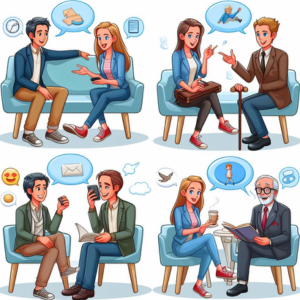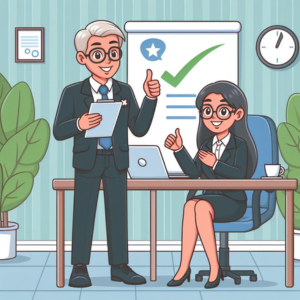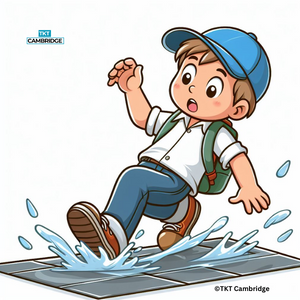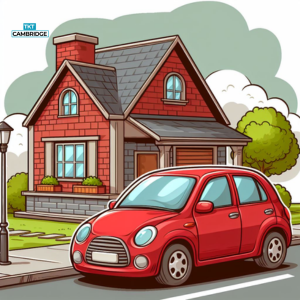Functions
The role of language functions is like being a versatile communicator – they help us express our intentions, connect with others, and navigate various social situations with ease. It’s like having a toolbox of language skills, each serving a specific purpose to ensure effective communication.
Language functions and exponents

Language exponents are expressions made up of special words or phrases that help us communicate specific things. Just like Ali Baba said “Open sesame!” to open a magic door, using the right exponent helps you greet, apologize, ask for things, give advice, share opinions, describe things, and many more.
Functions state the purpose, exponents articulate the purpose. In Ali Baba’s example,
The purpose: to get something done (open the door)
The articulation: “Open sesame”
Exercise 1:
Can you name the language function of each of the following exponents?
- “Could you please pass the salt?”
- “I’m sorry for being late.”
- “Thank you for your help.”
- “Turn left at the next intersection.”
- “Would you like some coffee?”
- “In my opinion, this is the best solution.”
- “Yesterday, I went for a walk in the park.”
- “I completely agree with your point.” / “I respectfully disagree.”
- “You should definitely try this new restaurant; the food is amazing.”
- “I’m so sorry to hear about your loss.”
Exercise 2:
Can think of some possible language exponents for each of the following functions?
- Greeting
- Apologizing
- Requesting
- Giving advice
- Expressing opinions
- Suggesting
- Prohibiting
- Clarifying
- Accepting
- Refusing
Exponents are essential in effective communication, as they guide us in expressing our intentions clearly and appropriately. By using the right exponents, we can engage in meaningful conversations and build strong connections with others.
Language formality

The language formality in functions are like the varying degrees of politeness and social appropriateness we use in different situations. It’s like adjusting the tone of our conversation to match the context and the people we’re interacting with. Just as we wouldn’t wear a tuxedo to a casual picnic, we adapt our language to suit the setting and the relationship with our conversation partners.
The choice of formality in functions depends on factors such as the relationship with the listener, the setting, and the purpose of the communication. Adapting the formality helps create a comfortable and respectful environment for all parties involved.
Let’s explore the different types of formality with examples.
Informal register:
This level is used with close friends, family members, or people you are very familiar with.
“Hey, what’s up?”
“Wanna grab some lunch together?”
Neutral register:
This level is appropriate for general conversations with acquaintances or colleagues.
“Hello, how are you doing?”
“Could you pass me the salt, please?”
Formal register:
This level is used in professional or official settings with people you don’t know well or in polite requests.
“Good morning, could you please provide me with the information?”
“I apologize for the inconvenience, but could you kindly reschedule the meeting?”
Important:
You should not get confused of these three types of registers (‘informal registers’, ‘neutral registers‘, and ‘formal registers‘) with ‘language registers‘ (which we will discuss next).
Exercise 3:
Match the types of formality (A-C) with the exponents (1-7). There could be more than one exponent on each register type.
Types of formality
A. Formal
B. Neutral
C. Informal
Exponents
- “It is a pleasure to meet you.”
- “I’m getting tired of this junk.”
- “Heard from her lately?”
- “What do you need?”
- “It is necessary for me to…”
- “This will be of great benefit to you.”
- “I would like to remind you that…”
Exercise 4:
Match the exponents (A-E) with the formality descriptions (1-5).
Exponents
A. “Anna’s right.”
B. “Let me know when you will be available.”
C. “It is my opinion that…”
D. “What’s up?”
E. “Thanks for your mail on 10 Mar.”
Formality descriptions
- A casual greeting used among friends or acquaintances
- An informal agreement with a colleague’s opinion
- A factual acknowledgment of communication
- A diplomatic way to express one’s viewpoint
- A straightforward request for information
Language registers

Language registers includes various styles or levels of language use based on formality. Language registers are like versatile language outfits, enabling us to communicate effectively in various social and professional settings. The choice of register ensures we fit in appropriately and maintain the communication with our audience clearly. Just like you wouldn’t wear gym clothes to a wedding, you wouldn’t use slang or casual language in a formal business meeting.
Language registers can be gauged on a scale from most formal to least formal. They reflect social cues, context, and personal expression.
Casual Register:
This register is used in informal, relaxed settings, such as among friends or family members.
“Hey, wanna hang out later?”
“I’m gonna grab some coffee, want anything?”
Colloquial Register:
Similar to casual, this register is used in everyday conversations but may include some regional or slang expressions.
“What’s up, dude?”
“I gotta run some errands.”
Neutral Register:
This register is appropriate for general interactions with acquaintances, colleagues, or in everyday situations.
“Hello, how are you?”
“Could you please pass me the book?”
Formal Register:
This register is used in professional or formal settings with people you don’t know well or to show respect.
“Good morning, how may I assist you?”
“I apologize for any inconvenience this may have caused.”
Technical Register:
This register is specific to certain fields and involves technical terminology or jargon.
“According to the data analysis, the ROI has increased by 10%.”
“The program uses a hybrid approach to solve complex equations.”
Literary Register:
Used in literature, poetry, or artistic expressions, this register may have more elaborate language and imagery.
“The golden rays of the setting sun kissed the tranquil sea.”
Official Register:
This register is for highly formal or ceremonial situations, such as in official documents or speeches.
“To whom it may concern, this letter serves as an official notification.”
Exercise 5:
Match the type of register (A-D) with the utterances (1-7). There could be more than one utterance on each register type.
Type of register
A. Casual
B. Neutral
C. Colloquial
D. Formal
Utterances
- “She’s got a real chip on her shoulder.”
- “Let’s bounce, this party’s lame.”
- “We are pleased to announce the launch of our new product line.”
- “Sorry, I spaced out for a sec there.”
- “I look forward to your prompt response to this matter.”
- “I’m beat, let’s call it a day.”
- “I’m interested in learning more about your project.”
Exercise 6:
Match the type of register (A-C) with the utterances (1-5). There could be more than one utterance on each register type.
Type of register
A. Official
B. Technical
C. Literary
Utterances
- “The moon cast an ethereal glow upon the tranquil lake.”
- “The results of the clinical trial indicate a statistically significant reduction in symptom severity.”
- “I hereby submit my resignation from the position of Chief Financial Officer, effective immediately.”
- “On behalf of the board of directors, I extend a warm welcome to all attendees present here today.”
- “The tensile strength of the material must exceed 500 megapascals to ensure structural integrity.”
Language appropriacy

Language appropriacy ensures that our communication is well-matched to the social context, making it more effective and respectful. Being aware of appropriacy helps us build better connections with others and fosters a positive and harmonious atmosphere in conversations.
Let’s explore language appropriacy with examples:
Casual Setting:
In a casual setting with friends, you can use relaxed language and slang:
Appropriate: “Hey, wanna grab a bite to eat?”
Inappropriate: “Greetings, would you care to partake in a culinary adventure?”
Formal Setting:
In a formal setting, such as a business meeting, using polite and professional language is appropriate:
Appropriate: “Good morning, I’d like to discuss the quarterly report.”
Inappropriate: “Yo, let’s talk about those numbers!”
Academic Setting:
In an academic environment, using formal language and avoiding contractions is usually appropriate:
Appropriate: “It is important to consider the implications of this research.”
Inappropriate: “It’s important to check out this study’s impact.”
Multicultural Context:
In a multicultural setting, using clear and straightforward language helps ensure understanding:
Appropriate: “Please let me know if you have any questions.”
Inappropriate: “Holla if ya got any queries, ya know?”
Respectful Language:
Using respectful language, especially when talking to elders or authority figures, is always appropriate:
Appropriate: “Excuse me, sir/ma’am, may I ask for your assistance?”
Inappropriate: “Hey, you! Help me out!”
Inclusive Language:
Inclusive language is appropriate when addressing diverse groups to avoid marginalization:
Appropriate: “Everyone is welcome to join the discussion.”
Inappropriate: “Only the best students are allowed to participate.”
Function types

Depending on it’s usage and role, functions can be categorised into several types such as
1. Personal functions
2. Interpersonal functions
3. Directive functions
4. Referential functions
5. Imaginative functions
Personal functions

Personal functions in language refer to how we use language to express our own thoughts, feelings, and experiences. It’s like giving others a glimpse into our inner world. Let me break it down with some examples to make it easier to understand.
Expressing Emotions:
Example: “I’m so excited about the upcoming concert! I’ve been waiting for it for months!”
In this case, the speaker is using language to convey their emotion of excitement about the concert.
Stating Opinions:
Example: “I think pizza is the best food ever!”
Here, the person is expressing their opinion about pizza and stating that they think it’s the best.
Sharing Experiences:
Example: “I went to the beach yesterday, and the waves were amazing!”
The speaker is sharing their personal experience of going to the beach and enjoying the awesome waves.
Revealing Preferences:
Example: “I prefer action movies over romantic comedies.”
This sentence tells us about the person’s preference for action movies as opposed to romantic comedies.
Asking for Advice or Help:
Example: “I’m having trouble understanding this math problem. Can you help me out?”
In this instance, the person is seeking help and expressing their need for assistance with a math problem.
Expressing Intentions:
Example: “I plan to start learning a new language this summer.”
The speaker is sharing their intention to learn a new language during the summer.
Describing Personal Goals:
Example: “I want to become a successful entrepreneur and build my own company.”
This sentence outlines the speaker’s personal goal of becoming an entrepreneur and starting their own business.
Inter-personal functions

Inter-personal functions in language are all about how we use communication to interact with others, build relationships, and manage social situations. It’s like the glue that holds our social interactions together, helping us connect with people, express our attitudes towards them, and coordinate our actions with theirs.
Greeting and Farewells:
Example: “Hey, how are you doing?” or “Goodbye, see you later!”
These simple phrases are used to greet someone when we meet them and bid them farewell when we leave.
Showing Politeness:
Example: “Excuse me, could you please pass me the salt?”
Polite language and manners play a crucial role in showing respect and consideration for others.
Apologies and Forgiveness:
Example: “I’m really sorry I broke your favorite mug. Can you forgive me?”
When we make mistakes or hurt someone, we use language to apologize and seek forgiveness.
Giving Compliments:
Example: “You did an excellent job on that presentation!”
We use compliments to appreciate and praise others for their achievements and efforts.
Expressing Gratitude:
Example: “Thanks a lot for helping me move to my new apartment!”
Gratitude is expressed to show appreciation for someone’s kindness or assistance.
Making Requests:
Example: “Could you please lend me your pen?”
When we need something from someone, we use language to make polite requests.
Offering Help:
Example: “Do you need any help with setting up the party?”
Offering assistance to others is a way to show our support and care.
Negotiating and Resolving Conflicts:
Example: “Let’s discuss a compromise that works for both of us.”
During disagreements, we use language to find solutions and reach compromises.
Giving Advice:
Example: “If I were you, I would take some rest and relax.”
We offer advice to guide others in certain situations.
Expressing Sympathy:
Example: “I’m so sorry to hear about your loss. My condolences to you and your family.”
When someone experiences a loss or hardship, we express sympathy to comfort them.
Directive functions

Directive functions in language are all about giving or seeking instructions, commands, or guidance. It’s like the traffic controller of communication, where we use language to direct others’ actions or request them to do something specific. These functions help us get things done, ask for help, or influence others’ behavior through verbal cues.
Giving Instructions:
Example: “Please turn off the lights before leaving the room.”
Here, the speaker is using language to provide a clear instruction to turn off the lights.
Making Requests:
Example: “Could you pass me the salt, please?”
When we need something from someone, we use language to make a request.
Giving Commands:
Example: “Close the door behind you.”
Commands are more direct than instructions and tell someone what to do.
Offering Suggestions:
Example: “You should try the seafood pasta. It’s delicious!”
Suggestions are a way to guide others’ choices or actions without being forceful.
Asking for Permission:
Example: “May I borrow your laptop for a while?”
When we want to do something that involves others or their belongings, we seek permission through language.
Providing Warnings:
Example: “Be careful on the slippery floor.”
Warnings alert others to potential dangers or risks.
Giving Advice:
Example: “You should start saving money for your future.”
Advice involves directing someone towards a particular course of action based on our perspective.
Making Offers:
Example: “Can I help you with your project?”
Offers are a way to extend assistance or support to others.
Expressing Invitations:
Example: “Would you like to come to my birthday party?”
Invitations invite others to participate in a specific event or gathering.
Suggesting Solutions:
Example: “Why don’t we try rescheduling the meeting for tomorrow?”
In problem-solving situations, we use language to propose solutions or alternatives.
Referential functions

Referential functions in language are all about conveying information and referring to things in the world around us. It’s like playing the role of a messenger, using language to describe, define, or identify people, objects, events, and ideas. These functions are all about sharing knowledge, facts, and descriptions to help others understand the world better.
Providing Information:
Example: “The sun rises in the east and sets in the west.”
In this case, the speaker is sharing a piece of information about the movement of the sun.
Defining Terms:
Example: “A polygon is a closed shape with straight sides.”
Defining terms helps others understand the meaning of specific words or concepts.
Identifying Objects:
Example: “The red car parked in front of the house is mine.”
By describing the car as “red” and its location, the speaker helps others identify which car belongs to them.
Describing Events:
Example: “Yesterday, there was a thunderstorm with heavy rainfall.”
Describing events helps others imagine or understand what happened.
Giving Directions:
Example: “Take the first left, and then go straight until you reach the blue building.”
When providing directions, we use language to refer to specific locations and landmarks.
Sharing Facts:
Example: “The Earth is the third planet from the Sun.”
Facts are objective information that we convey to others.
Reporting News:
Example: “The company announced a new product launch next month.”
News reports use language to refer to recent events or developments.
Explaining Concepts:
Example: “Photosynthesis is the process by which plants convert sunlight into energy.”
Explaining concepts involves referring to ideas or principles to make them understandable.
Referring to Data or Statistics:
Example: “According to the survey, 70% of people prefer tea over coffee.”
Data and statistics are used to refer to specific numerical information.
Quoting Information:
Example: “As Albert Einstein once said, ‘Imagination is more important than knowledge.'”
When we quote someone, we are referring to their exact words.
Imaginative functions

Imaginative functions in language are all about letting our creativity and imagination run wild. It’s like taking a trip to a magical land where we use language to create vivid mental images, tell stories, invent new worlds, and express our dreams and fantasies. These functions are all about exploring the realm of imagination and bringing it to life through words.
Telling Stories:
Example: “Once upon a time, in a faraway kingdom, there was a brave knight on a quest to rescue the princess from the clutches of an evil dragon.”
Here, the speaker is using language to weave a fantastical tale full of knights, princesses, and dragons.
Writing Fiction:
Example: “In a dystopian future, a group of rebels fights against a totalitarian regime to restore freedom and justice to the world.”
Writing fiction allows us to create imaginary worlds and characters, exploring endless possibilities.
Daydreaming and Fantasizing:
Example: “I wish I could fly like a bird and explore the world from above!”
We use language to express our fantasies and desires, even if they might be impossible in reality.
Playing Pretend:
Example: “Let’s pretend we’re pirates searching for buried treasure on a deserted island!”
Through pretend play, we use language to transform ourselves into different characters and embark on exciting adventures.
Crafting Poetry:
Example: “Under the moonlit sky, the stars twinkle like diamonds in the dark velvet blanket.”
Poetry allows us to use language in a beautiful and imaginative way, painting evocative images with words.
Creating Artistic Descriptions:
Example: “The sun dipped below the horizon, painting the sky with hues of orange, pink, and purple.”
Artistic descriptions use language to evoke sensory experiences and create a vivid mental picture.
Inventing New Words or Phrases:
Example: “Magiflorious – a word to describe something that’s both magical and glorious!”
Sometimes, we use language creatively by inventing new words or combining existing ones to express unique ideas.
Exploring Sci-Fi and Fantasy Scenarios:
Example: “Imagine a world where humans live side by side with advanced robots and travel to distant galaxies.”
We use language to delve into the realms of science fiction and fantasy, exploring futuristic or magical scenarios.
Next step
Back to Module 1 lesson navigator
Go to the previous lesson
Go to the next lesson
Related glossary terms
function
exponent
register
formal
informal
neutral
appropriacy
Download a copy of glossary here.
A message from the trainer
Congratulations, TKTier!

